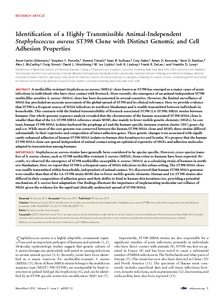Uhlemann, AC;
Porcella, SF;
Trivedi, S;
Sullivan, SB;
Hafer, C;
Kennedy, AD;
Barbian, KD;
McCarthy, AJ;
Street, C;
Hirschberg, DL;
et al.
Uhlemann, AC; Porcella, SF; Trivedi, S; Sullivan, SB; Hafer, C; Kennedy, AD; Barbian, KD; McCarthy, AJ; Street, C; Hirschberg, DL; Lipkin, WI; Lindsay, JA; DeLeo, FR; Lowy, FD
(2012)
Identification of a highly transmissible animal-independent Staphylococcus aureus ST398 clone with distinct genomic and cell adhesion properties.
MBio, 3 (2).
https://doi.org/10.1128/mBio.00027-12
SGUL Authors: Lindsay, Jodi Anne
![[img]](https://openaccess.sgul.ac.uk/1107/1.hassmallThumbnailVersion/mBio.00027-12.pdf)  Preview |
|
["document_typename_application/pdf; charset=binary" not defined]
Published Version
Download (788kB)
| Preview
|
Abstract
A methicillin-resistant Staphylococcus aureus (MRSA) clone known as ST398 has emerged as a major cause of acute infections in individuals who have close contact with livestock. More recently, the emergence of an animal-independent ST398 methicillin-sensitive S. aureus (MSSA) clone has been documented in several countries. However, the limited surveillance of MSSA has precluded an accurate assessment of the global spread of ST398 and its clinical relevance. Here we provide evidence that ST398 is a frequent source of MSSA infections in northern Manhattan and is readily transmitted between individuals in households. This contrasts with the limited transmissibility of livestock-associated ST398 (LA-ST398) MRSA strains between humans. Our whole-genome sequence analysis revealed that the chromosome of the human-associated ST398 MSSA clone is smaller than that of the LA-ST398 MRSA reference strain S0385, due mainly to fewer mobile genetic elements (MGEs). In contrast, human ST398 MSSA isolates harbored the prophage ϕ3 and the human-specific immune evasion cluster (IEC) genes chp and scn. While most of the core genome was conserved between the human ST398 MSSA clone and S0385, these strains differed substantially in their repertoire and composition of intact adhesion genes. These genetic changes were associated with significantly enhanced adhesion of human ST398 MSSA isolates to human skin keratinocytes and keratin. We propose that the human ST398 MSSA clone can spread independent of animal contact using an optimized repertoire of MGEs and adhesion molecules adapted to transmission among humans.
| Item Type: |
Article
|
| Additional Information: |
PMCID: PMC3302565 |
| Keywords: |
Adolescent, Animals, Anti-Bacterial Agents, Bacterial Adhesion, Child, Child, Preschool, DNA, Bacterial, Extracellular Matrix Proteins, Genome, Bacterial, Humans, Interspersed Repetitive Sequences, Keratinocytes, Methicillin, Microbial Sensitivity Tests, Molecular Sequence Data, New York City, Prophages, Sequence Analysis, DNA, Staphylococcal Infections, Staphylococcus aureus, Synteny, Virulence Factors |
| SGUL Research Institute / Research Centre: |
Academic Structure > Infection and Immunity Research Institute (INII) |
| Journal or Publication Title: |
MBio |
| PubMed ID: |
22375071 |
| Web of Science ID: |
22375071 |
| Dates: |
| Date |
Event |
| 2012 |
Published |
|
  |
Download EPMC Full text (PDF)
|
 |
Download EPMC Full text (HTML)
|
 |
Go to PubMed abstract |
| URI: |
https://openaccess.sgul.ac.uk/id/eprint/1107 |
| Publisher's version: |
https://doi.org/10.1128/mBio.00027-12 |
Statistics
Item downloaded times since 30 Apr 2012.
Actions (login required)
 |
Edit Item |




